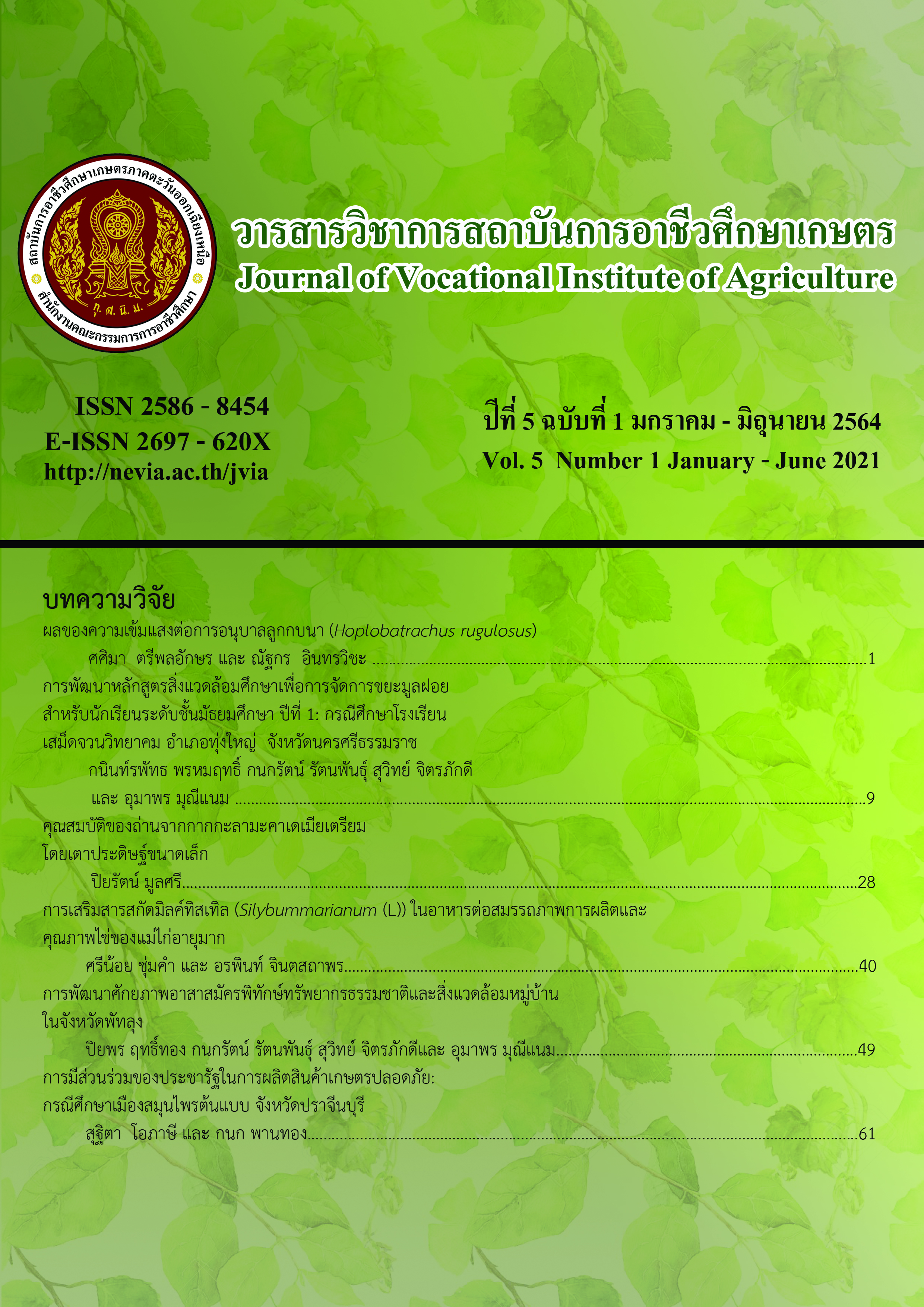Effect of Dietary Supplementation with Milk Thistle (Silybum marianum (L)) Extract on Performance and Egg Shell Quality of Older Laying Hens
Main Article Content
Abstract
The objective of this study was to investigate the effects of supplementing milk thistle in the diet of old laying hen on productive performance and egg quality. A total of 96 commercial laying hens, 85 weeksold, were randomly distributed in completely randomized design(CRD), 3 treatments and 4 replications with 8 birds in each replication. The experimental treatments were:1) basal diet, 2) basal diet supplemented with 60 ppm milk thistle and 3) basal diet supplemented with 150 ppm milk thistle. The experimental period was 12 weeks. The results revealed that egg production, egg weight, egg mass, feed intake/day, feed intake/dozen of egg, survival rate, feed cost/kg of egg, feed cost/egg, Hauge unit, yolk index, yolk color, specific gravity, egg shell thickness, egg shell weight, percentage of egg shell and shape index were not significant different (P>0.05). Feed intake/dozenof egg in group of basal diet supplemented with150 ppm milk thistle tended to be lower than other groups (P=0.09). Supplementing the diet with 60 ppm milk thistle indicated the significant effects (P<0.05) on redness (a*) and yellowness (b*) of egg yolk color but there were no significant difference in egg shell color (∆E) and brightness( L*). In conclusion, supplementing the diet with 150 ppm milk thistle tended to decrease feed intake for egg production.
Article Details

This work is licensed under a Creative Commons Attribution-NonCommercial-NoDerivatives 4.0 International License.
The content and information in articles published in the Journal of Vocational Education in Agriculture are the opinions and responsibility of the article's author. The journal editors do not need to agree or share any responsibility.
Articles, information, content, etc. that are published in the Journal of Vocational Education in Agriculture are copyrighted by the Journal of Vocational Education in Agriculture. If any person or organization wishes to publish all or any part of it or to do anything. Only prior written permission from the Journal of Vocational Education in Agriculture is required.
References
กองส่งเสริมและพัฒนาปศุสัตว์. (2563). สถานการณ์ปศุสัตว์ปี 2563. เข้าถึงได้จาก http://extension.dld.go. th/th1/images/stories/63.
Beck, M. M., & Hansen, K. K. (2004). Role of estrogent in avain osteoporosis. Poultry Science, 8, 200-206.
Brin, M. M., et al. (2016). Increasing persistency in lay and stabilising egg quality in longer laying cycles. What are the challenges ?. British Poultry Science, 57, 330-338.
Halliwell, B. (1995). Antioxidant characterization: Methodology and mechanism. Biochemical Pharmacologyl, 49, 1341-1348.
พรรนิภา ชุมศรี. (2545). สมุนไพรนานาชาติ. กรุงเทพฯ: คณะเภสัชศาสตร์ มหาวิทยาลัยมหิดล.
Luper, S. (1998). A review of plants used in the treatment of liver disease: Part 1. Alternative Medicine Review, 3(6), 410-421.
วจี ทิพรส และปราณีต โอปณะโสภิต. (2560). ระบบนำส่งยาซิลิมา. Thai Bullentin of Pharmaceutical Science, 12(2), 41-47.
Abdalla, A., et al. (2018). Effect of salimarin supplementation on the performance of developed chickens under summer condition 1-during growth period. Egyptian Poultry Science Journal, 38(1), 305-329.
ภุชงค์ วีรดิษฐกิจ และไพโชค ปัญจะ. (2558). อิทธิพลของการเสริมใบมะรุมผงในอาหารไก่ไข่ต่อสมรรถภาพการผลิตและคุณภาพไข่. วารสารวิทยาศาสตร์และเทคโนโลยี, 23(2), 293-305.
กานดา ล้อแก้วมณี และคณะ. (2559). ผลของการเสริมดอกทองกวาวผงในอาหารไก่ไข่ต่อสมรรถภาพการผลิตและคุณภาพไข่. วารสารเกษตรพระจอมเกล้า, 34(3), 86-95.
Khaleghipour, B., et al. (2019). Effects of silymarin on productive performance, liver function and serum biochemical profile in broiler Japanese quail challenged with dietary aflatoxins. Italian Journal of Animal Science, 18(1), 564-573.
Moradi, F., et al. (2017). The Effects of silymarin on oxidative status and bone characteristics in Japanese Quail subjected to oxidative stress Induced by carbon tetrachloride. Poultry Science Journal, 5(2), 97-104.
Gebhardt, R. (2002). Oxidative stress, plant derived antioxidants and liver fibrosis. Planta Medica, 68(4), 289-296.
Schonfeld, J. V., et al. (1997). Silibin, a plant extract with antioxidant and membrane stabilizing properties, protect exo-crine pancreas from cyclosporine A toxicity. Cellular and Molecular life Science, 53(11-12), 917-920.
Roush, W. B. (1981). T156 calculator programm for Haugh unit calculator. Poultry Science, 60, 1086-1088.
Pesti, G. M., et al. (2005). Poultry nutrition and feeding. Georgia: Althens Inc.
Ingram, D. R., et al. (2008). A study on the relationship between eggshell color and eggshell quality in commercial broiler breeders. International Journal of Poultry Science, 7(7), 700-703.
AOAC. (2000). Official method of analysis of association of official analytical chemists. Washington, D.C.: AOAC
Brand-Williams, W., et al. (1995). Use of a Free Radical Method to Evaluate Antioxidant Activity. LWT-Food Science and Technology, 28(1), 25-30.
Hashemi Jabali, N. S., et al. (2018). Effects of milk thistle meal on performance, ileal bacterial enumeration, jejunal morphology and blood lipid peroxidation in laying hens fed diets with different levels of metabolizable energy. Journal of Animal Physiology and Animal Nutrition, 102(2), 410-420.
Nascimento, D. R., et al. (2014). Effect of different vitamin D sources and calcium levels in the diet of layers in the second laying cycle. Brazilian Journal of Poultry Science, 16(2), 37-42.
Şekeroğlu, A., et al. (2016). Effects of egg shell color and storage duration on the external and internal egg quality traits of ATAK-S layer hybrids. Ciencia e investigación agrarian, 43(2), 327-335.
Ishikawa, S., et al. (2010). Photodynamic antimicrobial activity of avian eggshell pigments. FEBS Letters, 584(4), 770-774.

